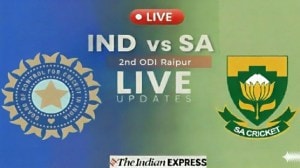Free trade? Not quite
Fashionable as free trade pacts are, the one signed between New Delhi and Colombo last week was less significant for India economically t...

Fashionable as free trade pacts are, the one signed between New Delhi and Colombo last week was less significant for India economically than politically. Long seen as the small-hearted South Asian giant, India can do with the halo of good neighbourliness the deal bestows on it.
And in economic terms? The agreement will facilitate, but not guarantee, the full realisation of the bilateral trade potential. That will depend on India’s will to favour free bilateral trade over domestic protectionism.India’s exports to Sri Lanka in 1997-98 were a modest Rs 1,772 crore. Measured against Sri Lankan exports to India, though, that is impressive: India took in a puny Rs 121.48 crore of imports from Sri Lanka last year, yielding a trade balance of Rs 1,605 crore in India’s favour. Is it any wonder that Colombo was so much more anxious to get this deal in the bag?Consider the size of Sri Lanka’s market, consider India’s, and draw your own conclusions about which country’s exports have the largest potential to grow withtrade liberalisation. On India’s part, that explains the tone of the agreement signed on December 28 — a willingness to free trade so long as it raises no hackles at home.
To those who say India has not learned its lessons from its World Trade Organisation experience this agreement should be an education: a free trade pact it may be, but it has all possible safeguards for contingencies or simply a protectionist mood. But first what the agreement looks like.
India is to eliminate tariffs on about 1,000 items as soon as the agreement comes into force. That will be within a month of the two countries notifying each other that they have met their constitutional and other requirements. The list of these items is to be ready within two months.
On other items, except those on a negative list, India will offer 50-per cent tariff concessions, and import tariffs on these will be eliminated altogether within three years. (Both countries will have separate negative lists and there will be no tariff concessions onthe items under them.)On textiles an item of concern for Indian industry tariff concessions have been limited to 25 per cent. There will be no concessions at all on several textiles imports.
India has kept under 400 items on its negative list, chiefly garments, petro-chemicals, alcoholic spirits, coconuts and coconut oil.Sri Lanka will remove tariffs on about 900 items when the agreement comes into force. On about 600 more items not on its negative list, it will offer 50 per cent tariff preference at the outset, which will increase to 70 and 90 per cent in the first and second year respectively. Tariffs on these will be fully eliminated at the end of the third year.
Except for negative list items, Colombo will cut tariffs on the remaining import items by at least 35 per cent within three years, 70 per cent within six years and remove them altogether within eight years.
Sri Lanka has yet to provide its negative list, but India has asked it to restrict this to 20 per cent of the tariff linesinvolved.
Rules of origin are crucial in deciding whether or not to give preferential treatment to exports which may originate partially (raw materials or unfinished products) in a third country but are finally exported by either India to Sri Lanka, or vice versa. To be recognised as an export originating in one of these two countries, such goods will require both a domestic value addition of at least 35 per cent, and that the goods undergo “substantial transformation” within these countries.
If India and Sri Lanka source their raw materials from each other, the rules of origin will require only 25 per cent domestic value addition.So much for the concessions. Even more noteworthy perhaps are the parts which allow either country to virtually suspend free trade in any item or series of items at the first sign of domestic trouble due to free imports.The Indo-Lankan agreement as a whole draws very heavily upon GATT 1994, the set of multilateral trade rules which has been coopted under the World TradeOrganisation. But the fine print of the Indo-Lankan accord is most revealing for another reason: the lessons that India has learned from its problems with the WTO accords and its determination to keep them at bay in this pact. Survey some of these provisions, and how India has been guided by their application in its trade with other trading partner countries.
Says one article: “Nothing in this agreement shall prevent…(India or Sri Lanka) from taking action and adopting measures which it considers necessary for the protection of its national security,…public morals, human, animal or plant life and health, and the protection of articles of artistic, historic and archaeological value (Articles XX, XXI of GATT ’94).”Perfectly GATT-consistent, but there is something worth noting here. The European Union has been alleging that after agreeing to remove curbs on a large number of imports by the year 2003, Indian has begun to restrict imports ostensibly on health, environment and other grounds. A large numberof a list of 600-odd imports it is restricting on such grounds, it says, has in fact nothing to do with health and other such concerns (allowed under GATT) but are simply disguised attempts at protectionism.
There is also an article on “safeguards” in the India-Lanka pact. Under GATT, if a sudden surge in any imports causes or threatens serious injury to domestic producers, these may be suspended. In the Indo-Lankan accord, it is specified that preferential treatment may be suspended on any such imports. India in fact has plans to put in place legislation that would help it use the safeguards provisions of the WTO effectively to curb import surges once it no longer physically restricts imports.
A third article in the India-Lanka accord says that balance of payments (BoP) difficulties may involve provisional suspension of preferential treatment on imports by either country. And thereby hangs a tale.The so-called BoP issue has become a big trade nuisance for India in recent years. Only two weeks ago, theWTO gave an interim ruling, in a case filed by America, that India no longer has a right — bestowed by (Article XVIII of) GATT on developing countries with BoP problems — to restrict imports on the ground that they have BoP difficulties.
So India has inserted a right into this agreement which the WTO disputes panel has said India does not have in the WTO regime.
Although the European Union is committed by an agreement last year not to litigate on the matter against India now that New Delhi has agreed to remove import curbs by 2003, it too has been telling India that invoking BoP cover to restrict imports is incompatible with India’s WTO obligations — an argument upheld this month by the WTO disputes panel. The question is only of how long India may take to remove such curbs. So India has taken ample care not to leave matters ambiguous in its bilateral agreement with Colombo.Finally, the full force of the WTO anti-dumping and anti-subsidy agreements will also apply in the bilateral accord. Any suspicionthat either country’s exporters are selling below cost or below a product’s normal value, or that exports are being subsidised by governments, can invoke action.
As much as free trade has been agreed on, it can in practice be made very unfree on several counts, whether real or mere protectionist ploys.
- 01
- 02
- 03
- 04
- 05































